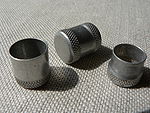



Here is a short story about my grand father´s love of pigeons.
The Egyptians and the Persians first used carrier pigeons 3,000 years ago. They also were used to proclaim the winner of the Olympics.
I do not remember my age but just at a guess about 12 years old, when I and at least one of my brothers where at my grand parents house, or arrived there and not getting any joy at the front door went down the side ofe the house to the back gate and entered the garden at the rear to find my grand father, Lewis George Hill, looking skyward and cooing. High above his head were two birds circling and catching the wind currents, he was fixed upon them and trying hard to catch their attention. He told us, myself and Malcolm, I think, that the birds were homing pigeons and more than likely had lost direction or had been blown off course, they were circling high to see any landmarks that could help them recapture the route back to base. He felt that they were getting exhausted and wanted them to drop down to a height were they could see he had food for them. The persistence paid off and the pigeons duly arrived on the tiled roof. From there they descended to the top of the out houses and then he encouraged them inside the small coal house. His attention was then drawn to the rings that had been placed on the legs of both birds, explaining to us that these rings could show both time and place that they had been released, for racing, with the identity of the owner and the birds registration. He kept the birds, not locked up during the day time but free to fly and sit in the open air, I cannot remember the sequence of events after but just that he discovered the owners and the birds were duly returned.

Racing
In short, competing birds are taken from their lofts and must race home. The time taken and distance are recorded and the fastest bird is declared the winner.
Provided it survives the many hazards associated with racing, a single pigeon could compete from about 6 months of age and still be in competition at over ten years of age. Such feats are uncommon, however, and the average racing career rarely exceeds three years.
To compete in a race, it must wear a permanent, unique numbered ring or band that is placed on its leg at about 5 days of age. For a race to be conducted, the competing pigeons must be entered into the race, usually at the organization's clubhouse, and taken away from their home to be released at a predetermined time and location. The distance between the bird's home loft and the race point is carefully measured by GPS and the time taken by the bird to return is measured using one of the two acceptable timing methods. Sometimes as in some leagues there are 2 divisions. One for the young birds (usually yearling's in their first year of competition and another for the old birds.
Traditional timing method
The traditional method of timing racing pigeons involves rubber rings with unique serial numbers and a specially designed pigeon racing clock. The ring is attached around the bird's leg before being sent to race. The serial number is recorded, the clock is set and sealed, and the bird carries the ring home. When the first bird returns, its trainer removes the ring and places it in a slot in the clock. The time that the ring was placed in the clock and is recorded as the official time that the competing bird arrived home. From this timestamp an average speed is measured and a winner of the race can be found.
Although serving its purpose, this method has proved somewhat problematic for a few reasons:
- The pigeon's "official time" is not the actual time it arrived, it is the time the ring was removed, placed in the clock and recorded, which could be many vital seconds later.
- Exceptional pigeons may arrive home first on multiple occasions; knowing it is going to have the ring removed speedily, which may be uncomfortable, the pigeon could be reluctant to enter the loft for the trainer.




Nenhum comentário:
Postar um comentário